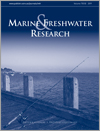Data obtained from sampling recreational fishers can provide valuable information to monitor marine resources and maintain social amenity for recreational fisheries. Trends in harvest rates of three species from retained catches of boat-based fishers in Port Phillip Bay, Australia, were generally within historical ranges. Harvest rates obtained from recreational fishing surveys can inform assessments of multisector fisheries or recreational-only fisheries.

Marine and Freshwater Research
Volume 70 Number 10 2019
MF18478Subtle variability in water quality structures tropical diatom assemblages in streams of Cape York Peninsula, Australia
Strong relationships were found between the types of diatoms found in streams and subtle differences in the environmental conditions on Cape York Peninsula, Australia. By modelling these relationships we can assess the health of these waterways and, using diatom fossils that preserve in wetland sediments, we can now recreate past conditions to study how the region has changed over thousands of years.
MF18310First records of polycyclic aromatic hydrocarbons and metals in sediments from a shallow lake in the Pampean–Patagonian region (Argentina)
 , Noelia S. La Colla, Andrés H. Arias, Sandra E. Botté, Gerardo M. E. Perillo and M. Cintia Piccolo
, Noelia S. La Colla, Andrés H. Arias, Sandra E. Botté, Gerardo M. E. Perillo and M. Cintia Piccolo
Surface sediment samples were collected from La Salada Lake, a saline shallow aquatic system located in Argentina, in order to assess the concentration of 16 priority polycyclic aromatic hydrocarbons and 8 metals, and the ecotoxicological effects of these pollutants based on sediment quality guidelines.
MF18211Concentrations and distribution of transparent exopolymer particles in a eutrophic coastal sea: a case study of the Changjiang (Yangtze River) estuary
We studied the concentrations of transparent exopolymer particles (TEPs) and their relationship with physical, chemical and biological conditions in the Changjiang (Yangtze River) estuary, and found that TEP concentrations correlated significantly positively with chlorophyll-a concentrations in spring and summer. The results also showed that TEP-carbon could represent a significant fraction of the particulate organic carbon pool in the study area.
MF18352Trophic ecology of large pelagic fish in the Saint Peter and Saint Paul Archipelago, Brazil
Trophic relationships of large pelagic predators can determine the structure and dynamics of oceanic food webs. We found that five large pelagic fish in the Saint Peter and Saint Paul Archipelago had high trophic specialisation, whereas most dietary overlaps were low. All species were classified as top predators, indicating high structural and functional importance in the food web of the Archipelago.
The reproductive biology of longtail tuna (Thunnus tonggol) in Australian waters was assessed using histology to provide life history parameter estimates for stock assessment. Females matured early in life at ~2–3 years of age and spawned on multiple occasions in tropical waters exceeding 25.5°C between October and February, where females generally produced ~1.5 million oocytes per spawning.
The geometric morphometric method was used to study morphometric variations between two seasonal migrants (monsoon and winter) of anadromous shad Tenualosa ilisha (Hamilton, 1822) from Hooghly Estuary, India. The results of relative warps, canonical variate analysis and discriminant function analysis clearly indicate the presence of two morphologically distinct stocks of T. ilisha migrating towards freshwater through Hooghly Estuary from the marine ecosystem for spawning purposes.
MF18072Equivalence of trophic structure between a tropical and temperate mangrove ecosystem in the Indo-Pacific
A comparison of a tropical mangrove with a temperate mangrove forest showed a marked degree of similarity in food chain length and primary carbon sources, suggesting a strong contribution of surface organic matter rather than mangrove detritus. This trophic similarity is remarkable given the distance between the two mangroves, differences in resource base and non-overlap of species assemblage.
MF18464Distribution of batoid demersal assemblages on the continental shelf of the Gulf of Tehuantepec
Demersal batoids were characterised from three sampling trips on the continental shelf of the Gulf of Tehuantepec and related to environmental variables. The environmental conditions and habitat characteristics predicted important changes in the batoid community and affected its spatiotemporal distribution pattern.
MF18459Effectiveness of the electric fish fence as a behavioural barrier at a pumping station
This study tested the effectiveness of fish protection by an electrified fish fence at a large dyke pumping station at the Danube River. Observed behavioural responses suggest that the electrified fish fence may be a promising tool in increasing the fish friendliness of pumping stations.
The reproductive biology of the Amazon River prawn was evaluated in populations with small- and large-size phenotypes in Brazilian reservoirs during the 2014–2016 ‘El Niño’ event. Despite the differences verified in fecundity values and indexes, both phenotypes showed continuous reproduction and similar reproductive aspects. ‘El Niño’ modified the reproductive patterns in a space–temporal scale, but did not directly affect the populations.
MF18362Prawn parade: notes on Macrobrachium australiense Holthius, 1950 climbing vertical concrete overflow steps at Gold Creek Reservoir, Queensland
We describe an observed climbing migration by the freshwater palaemonid shrimp, Macrobrachium australiense, from Queensland’s Gold Creek Reservoir in 2018. We briefly discuss this event in relation to a previous record of observed climbing migration at Queensland’s Dawson Weir, biogeography, intermittent current stimulus, and collective rheotactic response towards current source.
MF18473Thermal adaptation of Japanese sand lance (Ammodytes personatus) in different ocean currents revealed by the cytochrome-b gene
This study assessed the possible thermal selection on mitochondrial coding genes in the cold water species Ammodytes personatus. The population structure of this cold water species was explored, and the non-synonymous substitutions that may alter the function of the protein are discussed. This study may contribute to our understanding of the role of natural selection in shaping the geographical distribution of genetic variation in organisms and adaptation to changing environments.



